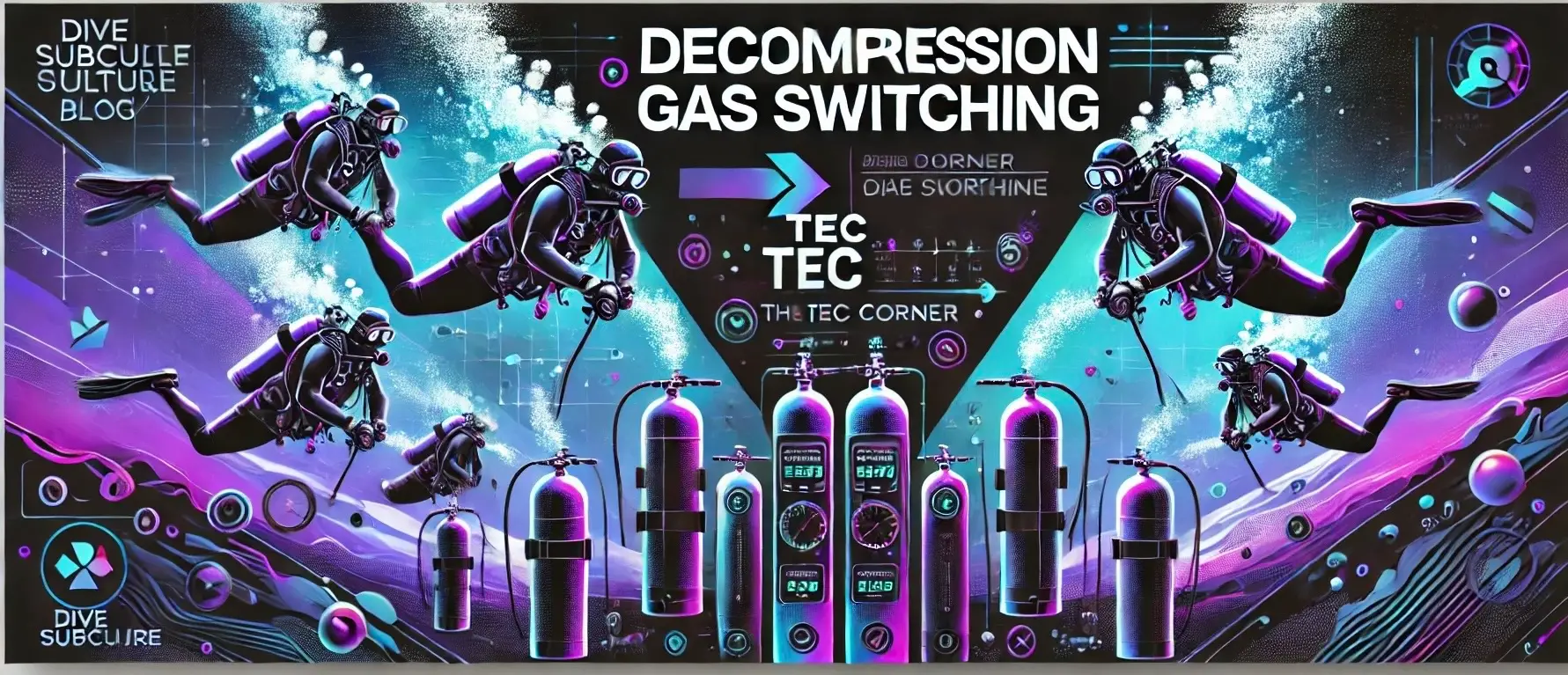By Dive Subculture Technical

Technical diving opens a gateway to deep exploration, requiring precise skills and discipline to manage various risks. One of the critical elements of technical diving is decompression gas switching—the act of changing gases at depth to manage decompression efficiently. This article will explore the process of switching gases, the importance of proper labeling, and essential safety protocols that every technical diver must follow to ensure smooth and safe gas management during complex dives.
Why Do Divers Switch Gases During a Dive?
As divers descend deeper, their bodies absorb nitrogen and other gases from their breathing mix. At depths beyond recreational limits, breathing air or nitrox alone becomes impractical due to the risks of nitrogen narcosis and oxygen toxicity. Technical divers use trimix (a blend of oxygen, nitrogen, and helium) to reduce these risks at depth and switch to higher oxygen-content gases during ascent to accelerate decompression. The switch from bottom gas to a deco gas ensures that nitrogen off-gassing occurs more efficiently, helping divers ascend faster and safer.
However, switching gases during decompression isn’t as simple as swapping out cylinders. It requires deliberate planning and execution to avoid errors that could result in catastrophic outcomes.
Proper Labeling of Decompression Cylinders
Cylinder identification plays a vital role in preventing mix-ups that could lead to fatal gas switching mistakes. Each decompression cylinder should be clearly labeled with:
1. Gas Contents – The exact percentage of oxygen, nitrogen, and helium (if applicable).
2. Maximum Operating Depth (MOD) – Clearly displayed to avoid using a gas mix at a depth where oxygen toxicity becomes dangerous.
3. Color-Coded Labels – While not standardized globally, many divers use green for oxygen-rich gases and yellow for standard nitrox. Ensure the labels align with your team’s protocols.
4. Personal Identification – Mark your cylinders with your initials or dive group identifier to avoid confusion when multiple divers are in the water.
5. Date of Blending – Helps confirm the gas was mixed and checked recently, preventing the use of expired or compromised gases.
The Process of Safe Gas Switching
Switching gases during a dive is one of the most critical points in technical diving. A wrong switch can cause oxygen toxicity, decompression illness (DCI), or hypoxia. Here are some essential steps to ensure safe gas switching underwater:
1. Pre-Dive Check and Team Confirmation:
• Before descending, all team members should verify the contents of their cylinders.
• Agree on the specific depths at which each gas will be switched and confirm these depths during the dive.
2. Gas Identification Underwater:
• Before switching gases, visually confirm the MOD label on your deco cylinder.
• Use hand signals to communicate your switch intentions with your team members.
• Always trace the regulator hose back to the cylinder to avoid grabbing the wrong gas mix.
3. S-Drill (Safety Drill):
• Perform regular S-drills to rehearse safe switching. This involves:
• Removing the appropriate regulator.
• Purging it to check for gas flow.
• Breathing from it before switching fully.
4. Gas Switch Confirmation:
• After switching gases, communicate with your dive buddy or team that the switch has been completed successfully using pre-agreed hand signals.
Key Safety Protocols for Decompression Gas Switching
1. Avoid Task Overload:
• Plan the switch points carefully and avoid performing gas switches while dealing with other tasks, such as navigating a wreck or managing reels during a cave dive.
2. Stick to the Plan:
• Decompression planning software provides switch depths for each gas. Stick to these depths to avoid oxygen toxicity or ineffective decompression.
3. Maintain Redundancy:
• Use multiple regulators and tanks with independent gas supplies to provide backup in case of failure.
4. Monitor Your Dive Computer:
• Use a dive computer that can handle multiple gases. Track your decompression obligations as you switch gases to ensure you stay within safe limits.
5. Buddy Checks and Communication:
• Before each gas switch, communicate clearly with your dive buddy or team. Confirm the gas, depth, and cylinder to avoid fatal errors.
Common Errors in Gas Switching and How to Avoid Them
1. Switching to the Wrong Gas:
• Ensure each cylinder is labeled properly and confirm the MOD before switching.
• Trace the regulator hose to avoid grabbing the wrong cylinder.
2. Switching at the Wrong Depth:
• Plan your gas switch points carefully and keep an eye on your depth gauge to avoid switching too soon or too late.
3. Forgetting to Purge the Regulator:
• Failing to purge a regulator could lead to inhaling stale air or water. Make it a habit to purge before every gas switch.
4. Equipment Malfunctions:
• Regularly service your regulators and check all valves before diving. Always carry a backup plan for potential failures during the dive.
Conclusion
Decompression gas switching is a cornerstone of technical diving, enabling deeper and safer exploration. However, it demands precision, planning, and rigorous safety protocols. Proper labeling of deco cylinders, along with careful gas switch procedures and clear communication, can help prevent the dangers associated with incorrect gas management.
At Dive Subculture’s Tec Corner, we emphasize the importance of training, preparation, and discipline in mastering gas management skills. Technical diving offers extraordinary adventures, but only with the right knowledge and habits can divers unlock these experiences safely.
Explore your limits with caution, label your gases carefully, and remember: your safety underwater begins with the decisions you make on the surface. Stay tuned for more insights and advanced tips at The Tec Corner on Dive Subculture Blog.







